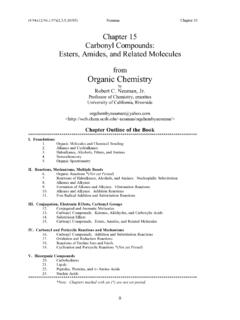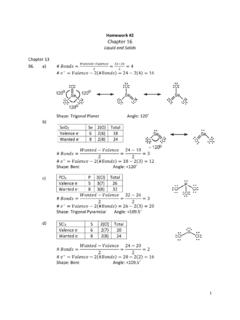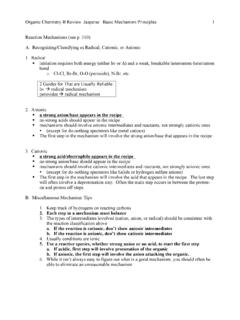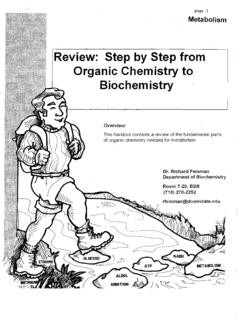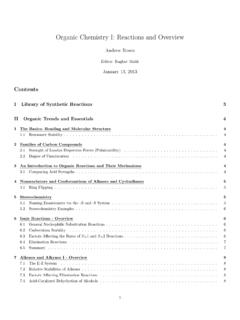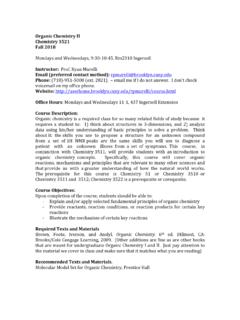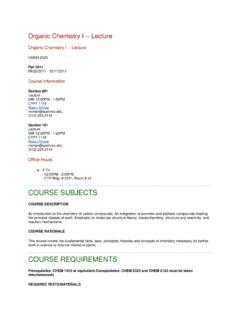Transcription of from Organic Chemistry - people.chem.ucsb.edu
1 (2/94)(9-11/95)(1-4/00) Neuman Chapter 5 0 Chapter 5 Organic Spectrometry from Organic Chemistry by Robert C. Neuman, Jr. Professor of Chemistry , emeritus University of California, Riverside < ~neuman/orgchembyneuman/> Chapter Outline of the Book ** I. Foundations 1. Organic Molecules and Chemical Bonding 2. Alkanes and Cycloalkanes 3. Haloalkanes, Alcohols, Ethers, and Amines 4. Stereochemistry 5. Organic Spectrometry II. Reactions, Mechanisms, Multiple Bonds 6. Organic Reactions *(Not yet Posted) 7. Reactions of Haloalkanes, Alcohols, and Amines. Nucleophilic Substitution 8. Alkenes and Alkynes 9. Formation of Alkenes and Alkynes.
2 Elimination Reactions 10. Alkenes and Alkynes. Addition Reactions 11. Free Radical Addition and Substitution Reactions III. Conjugation, Electronic Effects, Carbonyl Groups 12. Conjugated and Aromatic Molecules 13. Carbonyl Compounds. Ketones, Aldehydes, and Carboxylic Acids 14. Substituent Effects 15. Carbonyl Compounds. Esters, Amides, and Related Molecules IV. Carbonyl and Pericyclic Reactions and Mechanisms 16. Carbonyl Compounds. Addition and Substitution Reactions 17. Oxidation and Reduction Reactions 18. Reactions of Enolate Ions and Enols 19. Cyclization and Pericyclic Reactions *(Not yet Posted) V. Bioorganic Compounds 20.
3 Carbohydrates 21. Lipids 22. Peptides, Proteins, and Amino Acids 23. Nucleic Acids ** *Note: Chapters marked with an (*) are not yet posted. (2/94)(9-11/95)(1-4/00) Neuman Chapter 5 1 5: Organic Spectrometry Preview 5-4 Spectrometry in Organic Chemistry 5-4 Types of Spectrometry ( ) 5-5 Mass Spectrometry (MS) Nuclear Magnetic Resonance Spectrometry (NMR) Infrared Spectrometry (IR) Ultraviolet-Visible Spectrometry (UV-Vis) Mass Spectrometry (MS) 5-6 Formation of Molecular and Fragment Ions ( ) 5-6 Molecular Ion Fragment Ions Molecular and Fragment Ions from Methane. The Mass Spectrometer and Mass Spectrum ( ) 5-8 Mass Spectrometer Mass Spectrum Mass-to-Charge Ratios (m/z Values Peaks for the Molecular Ion and Fragment Ions Hexane ( ) 5-10 Molecular Ion and Fragment Ions from Hexane Exact Mass Values M+1 Peaks and Isotopes Mass Spectra of Hexane Structural Isomers ( ) 5-13 The Molecular Ion Peaks Fragmentation Mass Spectra of Compounds with Functional Groups ( ) 5-17 General Features 1-Pentanol (Y = OH) 1-Pentanamine (Y = NH2) 1-Chloropentane (Y = Cl 1-Bromopentane (Y = Br) 1-Iodopentane (Y = I) Mass Spectrometry Summary ( )))
4 5-21 Spectrometry Using Electromagnetic Radiation 5-22 Electromagnetic Spectrum ( ) 5-22 Photons of Electromagnetic Radiation Frequency and Wavelength of Electromagnetic Radiation Units of Frequency or Wavelength Basic Spectrometer Design ( ) 5-25 Spectrometer Components Spectral Peaks(2/94)(9-11/95)(1-4/00) Neuman Chapter 5 2 Nuclear Magnetic Resonance Spectrometry 5-26 The NMR Spectrometer ( ) 5-26 1H and 13C are NMR Active Nuclei ( ) 5-27 13C NMR Spectrometry 5-27 General Considerations ( ) 5-27 Some 13C NMR Spectra ( ) 5-28 Methanol versus Ethanol The Other Alcohols 13C NMR Chemical Shifts ( ) ( ) 5-28 Generalizations for these Alcohols Chemical Shifts Depend on Electron Prediction of 13C Values Calculations for 1-Hexanol Values and Electronegativity Chemically Equivalent Carbons Additional Details about NMR Spectra ( ) 5-36 Shielding High and Low Field The TMS Reference in 13C NMR Solvents Used in NMR Spectrometry.
5 Qualitative Predictions of 13C Spectra ( ) 5-37 1H NMR Spectrometry 5-38 1H versus 13C NMR Chemical Shifts ( ) 5-38 1H NMR Spectrum of Bromoethane ( ) 5-39 The Origin of the 1H NMR Signals The Shapes of the Signals Signal Splitting in 1H NMR Spectra ( ) 5-41 1-Bromoethane 2-Bromopropane 1-Bromopropane The Origin of 1H NMR Signals The Origin of Signal Splitting in 1H NMR Spectra The Relative Intensity of NMR Signals ( ) 5-48 Signal Intensities in 1H NMR Spectra Signal Intensities in 13C NMR Spectra 1H NMR Chemical Shift ( ) Values ( ) 5-49 The TMS Reference in 1H NMR. (2/94)(9-11/95)(1-4/00) Neuman Chapter 5 3 Infrared Spectrometry 5-50 Infrared Energy Causes Molecular Vibrations ( ) 5-52 The Infrared Spectrometer ( ) 5-52 IR Sample Cells Solvents for IR Samples.
6 IR Spectra ( ) 5-53 The Horizontal Axis The Vertical Axis. IR Stretching and Bending Signals ( ) 5-54 Characteristic IR Regions Alkanes Amines More IR Later UV-Visible Spectrometry 5-58 Structural Requirements for UV-Vis Spectra ( ) 5-58 UV and Visible Radiation Excites Electrons ( ) 5-59 The UV-Vis Spectrometer ( ) 5-59 UV-Vis Sample Cells Solvents for UV-Vis Spectrometry UV-Vis Spectra ( ) 5-61 The Horizontal Axis The Vertical Axis More UV-Vis Later Chapter Review 5-63 (2/94)(9-11/95)(1-4/00) Neuman Chapter 5 4 5: Organic Spectrometry Spectrometry in Organic Chemistry Mass Spectrometry Spectrometry Using Electromagnetic Radiation Nuclear Magnetic Resonance Spectrometry 13C NMR Spectrometry 1H NMR Spectrometry Infrared Spectrometry UV-Visible Spectrometry Preview This chapter describes four instrumental methods that Organic chemists routinely use to determine the structures of Organic compounds.
7 They are Mass Spectrometry (MS), Nuclear Magnetic Resonance Spectrometry (NMR), Infrared Spectrometry (IR), and Ultraviolet-Visible Spectrometry (UV-Vis). These four methods use electronic instruments called spectrometers to generate spectra that contain the structural information about molecules. We will describe these spectrometers only in the most general terms. This chapter is primarily designed to introduce you to the utility and limitations of these four instrumental methods, and to illustrate how Organic chemists use their spectral data to determine structures of Organic molecules. Analytical Chemistry is the branch of Chemistry that deals with the development and use of instrumental techniques such as these to determine structures of molecules, and it is the subject of other courses in the undergraduate Chemistry curriculum.
8 However, these four instrumental methods are of such great importance to Organic chemists that we give this early introduction to show the kinds of structural information they provide. Spectrometry in Organic Chemistry Organic chemists must determine structures of the Organic compounds that they use in chemical reactions, that form in these chemical reactions, and that they isolate from living organisms. They accomplish this using several instrumental techniques collectively described as Organic spectrometry. Organic spectrometry makes use of electronic instruments called spectrometers (2/94)(9-11/95)(1-4/00) Neuman Chapter 5 5 that provide energy to molecules and then measure how the molecules respond to that applied energy.
9 In order to fully understand spectrometry, we should learn about the design and construction of spectrometers. However we can develop a practical understanding of how these different types of Organic spectrometry provide information about molecular structure without a detailed knowledge of spectrometers. We illustrate this in the following sections using as examples the classes of Organic molecules introduced in Chapters 2 and 3. Types of Spectrometry ( ) The four most important types of spectrometry that Organic chemists routinely use are: Mass Spectrometry (MS) Nuclear Magnetic Resonance Spectrometry (NMR) Infrared Spectrometry (IR) Ultraviolet-Visible Spectrometry (UV-Vis) Each of these methods provides unique information about Organic molecular structure because each monitors the response of an Organic molecule to a different type of energy input.
10 In MS, a molecule is bombarded with a beam of high energy electrons, in NMR it is irradiated with radio waves, in IR it is subjected to heat energy, while in UV-Vis spectrometry the molecule is placed in a beam of ultraviolet or visible light. We discuss mass spectrometry (MS) first since it is fundamentally different from the other three types of spectrometry. Of the other three methods, we consider NMR in much greater detail than either IR or UV-Vis because of its overwhelming importance to Organic chemists as an aid in structure determination. Our discussions of IR and UV-Vis in this chapter are brief because these methods are best suited to analyzing types of molecules that we have not yet introduced.
